Bioenergy
-
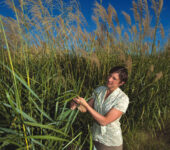
Miscanthus Plot
Caption from 2010 publication: Joint Bioenergy Institute’s director of Grass Genomics, Pam Ronald, in the Miscanthus plot at the University of California, Davis.
-
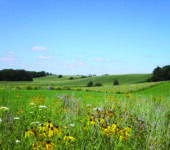
Marginal Lands with Flowers
Flower-dotted marginal land in the foreground contrasts sharply with more uniform traditional croplands of corn and alfalfa in the distance. Great Lakes Bioenergy Research Center (GLBRC) scientists have shown that perennial crops grown on marginal lands not currently in use for food production could provide large quantities of biomass and major ecological and environmental benefits.
-
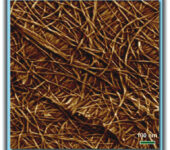
Microfibril Bundles
Atomic force micrograph showing nanometer-scale detail of interwoven rope-like, lignocellulosic microfibril bundles in a switchgrass cell wall.
-

Lignin Cross-Section
Stained lignin in cross-section of a cell wall in straw.
-
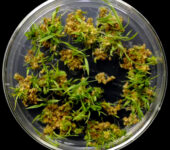
Petri Dish with Switchgrass
Improving Tools for Studying Switchgrass. BioEnergy Science Center–developed genetic transformation protocols and databases for switchgrass are helping accelerate research of this bioenergy feedstock.
-

Plant Scientists in Laboratory
Crosscutting and Multiscale Approach. Biodesign lies at the core of the Genomic Science Program’s three primary research focus areas: Bioenergy, Environmental Microbiome, and Biosystems Design. Plant scientists tend to tobacco plants, an important research tool for transient genetic transformation and protein expression. Pictured are Jillian Curran and her mentor Chien-Yuan “Kevin” Lin from the Biotech Partners Student Interns at Emery Station East.
-
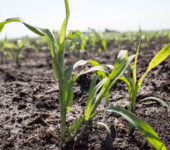
Plant Seedling
Plants as Factories. CABBI is creating crops that can make ready-to-use fuels and other high-value chemicals directly in their bodies. The goal is to simply squeeze these ready-made products out of a plant’s stems and leaves.
-
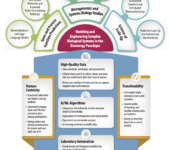
Modeling and Engineering Complex Biological Systems in Bioenergy Research
Numerous outcomes (circles at top) can be realized by pursuing fundamental and applied artificial intelligence and machine learning (AI/ML) research and tool development specific to the bioenergy research paradigm, including high-quality data, AI/ML algorithms, and laboratory automation (green box at center). Successful projects will include transferability and human centricity features (yellow left and right boxes) which are fundamental to disruptive changes in the bioenergy field.
-

Researchers with BioLector Instrument
Joint Bioenergy Institute scientists work with the BioLector instrument to understand the microbial production of biofuels and bioproducts.
-
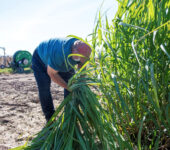
Oilcane Harvest
CABBI researcher Scott McCoy harvests a Saccharum line, engineered to hyperaccumulate oils in its vegetative biomass, for bioprocessing.